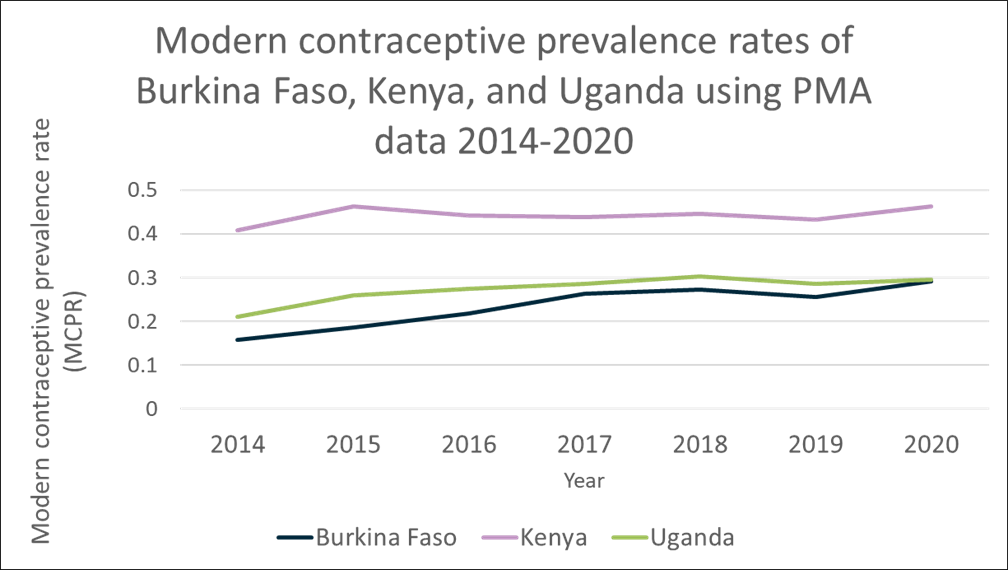By Devon Kristiansen
When Performance Monitoring for Action (PMA) initiated data collection in 2013, the survey design was a high-frequency, cross-sectional series with a focus on family planning, water, and sanitation indicators. Beginning in 2019, PMA refocused on reproductive and sexual health, and adjusted the survey design to add a contraceptive calendar and a longitudinal panel of women of childbearing age to observe contraceptive and fertility dynamics.
In order help researchers leverage the rich data from the redesigned PMA, IPUMS PMA has updated its online data dissemination system to provide longitudinal data in long form or wide form, delivering data files that link the women’s panel records.
The longitudinal data are designed to allow for analysis of contraceptive uptake, discontinuation, and method switching, as well as changes in fertility intentions and actualization over time. However, the redesigned survey also includes many new questions, including questions about domestic violence, women’s economic empowerment, abortion, health care access during COVID-19, and many other topics.
Table 1: Continuation and discontinuation of family planning among women aged 15-49 using family planning in the Performance Monitoring for Action Phase 1 Baseline Survey 2019-2020, weighted estimates
| Percent of women who discontinued family planning | Percent of women still using family planning | Percent of women using the same method of those still using family planning | |
|---|---|---|---|
| Burkina Faso | 35.4 | 62.6 | 77.0 |
| Kinshasa, DRC | 32.7 | 66.6 | 77.6 |
| Kongo Central, DRC | 33.8 | 65.9 | 77.7 |
| Kenya | 21.2 | 78.3 | 75.2 |
| Lagos, Nigeria | 33.3 | 64.7 | 80.9 |
| Kano, Nigeria | 44.9 | 55.1 | 83.7 |
Table 1 provides an example of leveraging the longitudinal data to observe changes in contraceptive uptake and discontinuation. Over the course of one year, the number of women who discontinued family planning ranged from 21% (Kenya) and 45% (Kano, Nigeria). Of the women who continued to use family planning, between 75 percent (Kenya) and 83.7 percent (Kano, Nigeria) used the same method between the baseline and first follow-up survey.
We can also study contraceptive method switching with the PMA longitudinal panel data. Of the women who were using a different contraceptive method between the baseline and first follow-up survey, the majority were still utilizing a method within the same broad category as before (e.g., long-acting, short-acting, or traditional). Long-acting methods include implants, IUDs, and sterilization, short acting methods include injectables, the pill, condoms, diaphragm, and foam/jelly, and traditional methods (for the purpose of this blog post) include rhythm, standard day beads, withdrawal, and all other unspecified traditional methods.
Table 2: Proportion of method types used among women aged 15-49 who switched methods between baseline and first follow up, weighted estimates (Burkina Faso, Democratic Republic of the Congo, Kenya, and Nigeria)
| First follow-up survey | ||||
| long-acting or permanent | short-acting, or reversible | traditional | ||
| Baseline survey | long-acting or permanent | 86.75 | 11.41 | 1.84 |
| short-acting or reversible | 9.82 | 82.43 | 7.76 | |
| traditional | 7.11 | 22.3 | 70.6 | |
The baseline survey in four countries (Burkina Faso, Democratic Republic of the Congo, Kenya, and Nigeria) were fielded before the COVID-19 pandemic, and so are an unexpected source of data to study the effect of COVID on women’s reproductive health conditions and outcomes before and after the pandemic. Many women of this panel were also reached by phone in the PMA COVID-19 survey (also available on the IPUMS PMA website), and these records can be linked to the longitudinal panel data using the variable FQINSTID.
Cross sectional data
If you’re interested in analyzing family planning indicators over time using previous survey rounds from PMA, IPUMS PMA also provides a subsample of the new survey rounds that can be treated as a representative cross-sectional data file.
Additional resources
The new survey design is complex, but we know it has so much potential to be used by the research community. IPUMS PMA created a new video tutorial to guide users through requesting longitudinal data through our updated online data dissemination system, and added new documentation to our sample notes page to describe these new data.
IPUMS is collaborating with the PMA team to host a Population Association of America side event during the 2022 PAA Annual Meeting to demonstrate how to analyze the longitudinal panel data. The side event will be a virtual workshop from 8am-9:30am Eastern Time on April 6th, 2022.
Lastly, the IPUMS PMA Data Analysis Hub blog will be producing a 6-part series deep-dive into these longitudinal data and how to use them starting in March 2022. Stay tuned!

